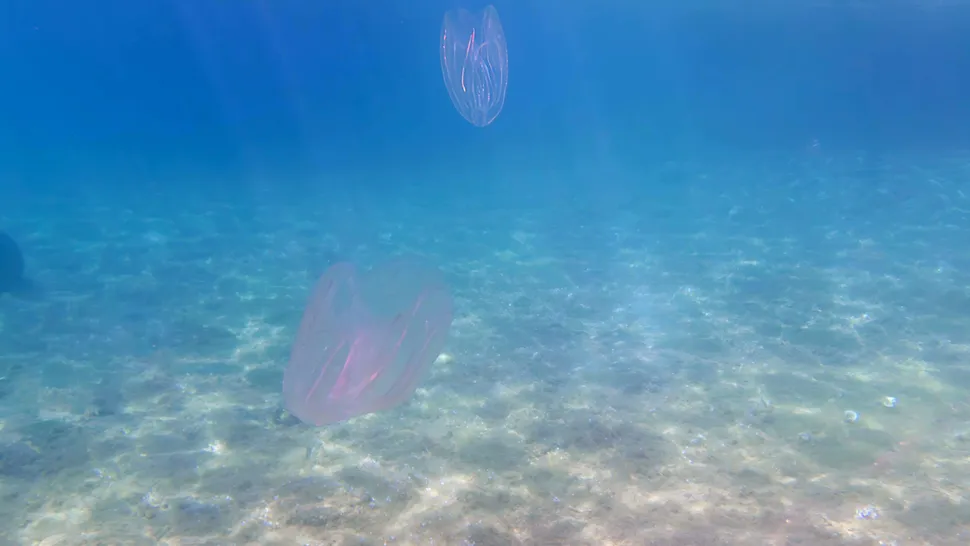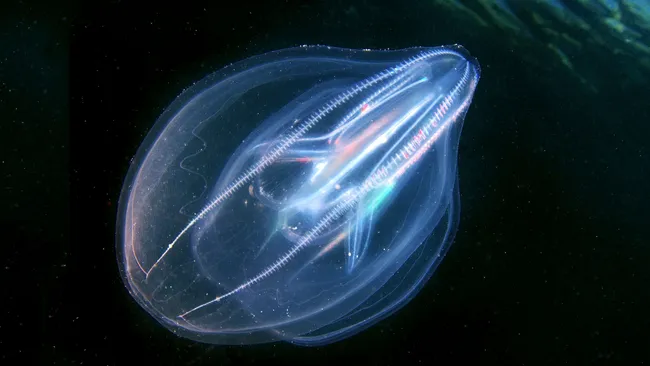Researchers discovered that some comb jellies can fuse their bodies together when injured. The unique adaptation, which involves merging their nervous systems and stomachs, has never been seen in any other species.

Discovery of Fused Comb Jellies
Bizarre deep-sea creatures known as comb jellies can fuse together when they are injured, creating a single massive individual with permanently combined nervous systems and stomachs, a new study reveals. This unusual adaptation has never been seen before in any other species, researchers say.
Accidental Lab Finding
The researchers discovered the fused jellies by accident in the lab.
“I was very excited [when I found them],” study lead author Kei Jokura, an evolutionary biologist at the University of Exeter in the U.K. and Japan’s National Institutes of Natural Sciences in Okazaki, told Live Science in an email. “I immediately took the fused comb jellies from the room where I was keeping them and showed them to the other lab members.”
What are Comb Jellies?
Comb jellies, also known as ctenophores, are a group of more than 100 species of gelatinous, blob-like creatures with small, comb-like tentacles. These alien-looking animals, which appear similar to jellyfish, create luminous displays in the deep sea by lighting up specialized cells throughout their translucent bodies. They are often considered some of the most bizarre creatures in the deep sea and are believed to be one of humanity’s most ancient ancestors.
A Surprising Adaptation
In the new study, published on Oct. 7 in the journal Current Biology, researchers describe how they were carrying out routine research on warty comb jellies (Mnemiopsis leidyi), also known as sea walnuts, when they discovered that one of their test subjects was missing from a tank in their laboratory. The team then noticed that one of the remaining jellies was unusually large. Upon closer inspection, they realized it was actually two intertwined individuals with “no apparent separation between them.”
Experimental Evidence of Fusion
The researchers suspected that this fusion was a previously unknown adaptation triggered by both animals sustaining injuries. To prove this, they attempted to replicate the fusion process by removing small sections of the bodies from 20 individuals and pairing them up near each other — and nine of the pairs successfully fused together. (The researchers considered the induced injuries “minor” compared to those they might get in the wild.)
Rapid Fusion and Neural Integration
The injured jellies merged quickly, often fully combining within 24 hours of being put together. Within two hours of fully fusing their bodies, the pairs demonstrated that their nervous systems had fully synced up by reacting to stimuli, such as being poked by researchers, across their entire shared body. This rapid neural integration is most likely due to the jellies’ unique nerve cells, which connect in a way unlike any other animals’ neurons.
Merged Stomachs
The researchers also fed the fused jellies fluorescent shrimp to test if their stomachs had merged. Food ingested by one of the jellies’ mouths could be seen moving across both stomachs, confirming the merger.
Are They a Single Organism?
While the fused creatures acted as one, they aren’t considered a single organism because they have separate DNA and cannot pass their “unique morphology” on to the next generation, Jokura said. “However, watching the fused individuals swim, they truly appear as if they are functioning as a single organism, so it wouldn’t be unreasonable to think of them that way,” he added. The researchers frequently refer to fused individuals as “single entities” in the new paper.
A Unique Phenomenon
The researchers believe this is the first known case of any organisms being able to fuse together in this way. “So far, there have been no reports of this type of fusion in other species,” Jokura said.
Why Has This Behavior Gone Unnoticed?
The behavior has likely gone unnoticed among comb jellies because it is probably extremely rare in the wild, Jokura added. Injured individuals must be in close proximity to one another for the merging to happen, which is much less likely in the deep sea. This species of comb jelly can also recover from injuries by regenerating lost body parts and by reversing the aging process, making fusion with other individuals less necessary.
Future Research Directions
Most of the fused pairs were still alive after three weeks when the study ended due to a lack of funding. However, Jokura suspects the fused jellies could have survived much longer. He also speculated that more than two injured individuals could fuse, though the team hasn’t tested that yet. The researchers are now preparing to start a similar study on individuals from another comb jelly species, Bolinopsis mikado, to see if they are also capable of fusing.
